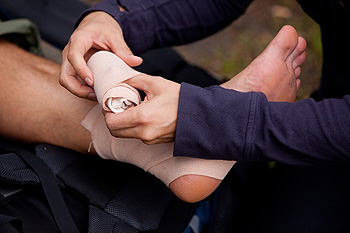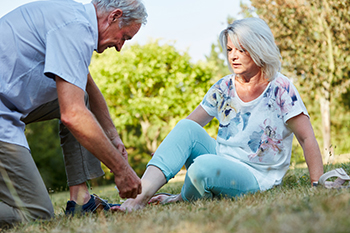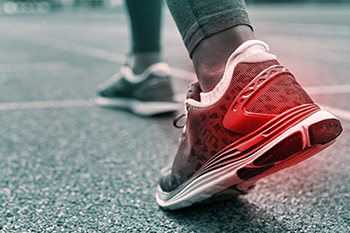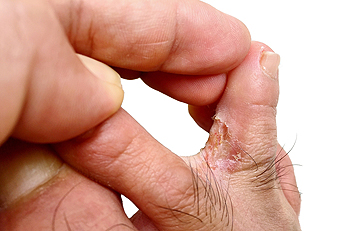
Many people who are involved in sports are familiar with injuries caused by sprains and strains. Sprains are caused by the tearing or rupture of a ligament. Strains are caused by a tearing or rupture of a muscle or tendon. Signs that you may have a sprain or strain include pain, tenderness, or weakness in the foot, ankle, or toe joints, as well as bruising and swelling. Muscle cramps or spasms may indicate a strain. If bearing weight causes pain or inhibits daily activities, a sprain or strain may be the cause. To help prevent sprains and strains it is a good idea to warm up before and cool down after exercising with stretches. Wearing shoes that fit properly and provide ample support and cushioning is a good way to prevent injury. If the pain from a sprain or strain does not diminish after following a course of rest, ice, compression, and elevation, it is suggested that you make an appointment with a chiropodist. This foot specialist can thoroughly examine the site of the injury and determine further treatment options.
Injuries to the foot and ankle are very common among athletes. If you have experienced an injury, please consult with one of the chiropodists from The Footcare Centre. Our chiropodists will assess your condition and provide you with quality foot and ankle treatment.
Common Injuries Among Athletes:
Achilles tendon injuries
Ankle strains or sprains
Plantar fasciitis
Fractures
Turf toe
Joint dislocations
Sever’s disease
Morton’s neuroma
Symptoms
Symptoms will depend on the cause and severity of the injury. Common symptoms for a foot or ankle injury include pain, swelling, tenderness, bruising, a reduced range of motion, and difficulty bearing weight or walking on the affected foot or ankle.
Diagnosis
Sports injuries are typically diagnosed after carefully examining the affected foot or ankle. This includes moving the injured area to test its range of motion. Medical history will need to be provided, as well as detailed information about how the injury occurred. Imaging studies, such as X-rays or MRIs, may be used to confirm or rule out certain diagnoses.
Treatment
Just like symptoms, treatment will depend on the type of injury and its severity. Initial treatment for many sports injuries is aimed at controlling inflammation and promoting the healing response. The acronym R.I.C.E is a helpful guide to implement for most acute injuries. This method involves resting, icing, compressing, and elevating the affected foot or ankle. In addition, anti-inflammatory medications may be administered and orthotic devices may be prescribed. For more severe injuries, surgery may be required. Lastly, rehabilitation or physical therapy may be needed to gain full functionality in the afflicted area.
If you have any questions, please feel free to contact our office located in . We offer the newest diagnostic and treatment technologies for all your foot care needs.





